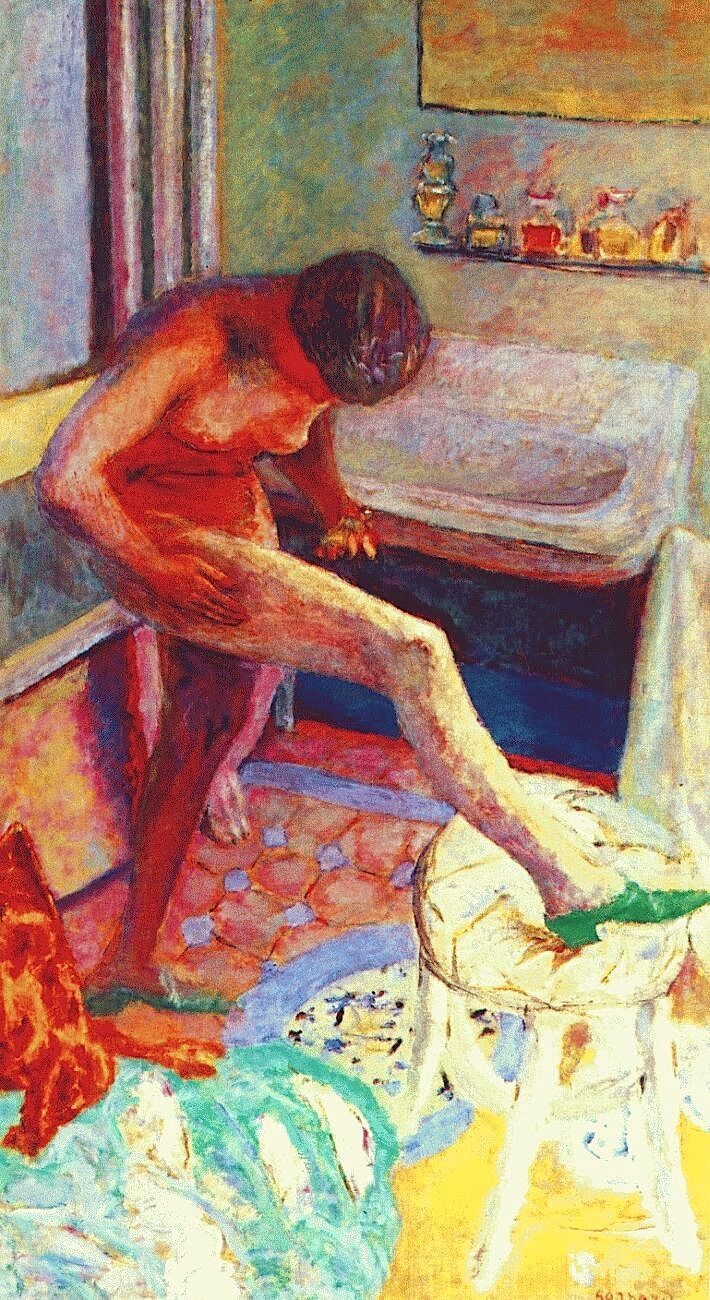A figure depicted in the process of getting dressed or undressed calls into question the difference between nudity and nakedness. Art historian Kenneth Clark might argue that this is a depiction of nakedness, as it highlights the deprivation of clothes. As John Beger sums up in ‘Ways of Seeing’ – “Nakedness reveals itself. Nudity is placed on display. To be naked is to be without disguises.“ The body in the process of being revealed or concealed is by his definition nakedness.
The semi-clothed figure has also been the subject of art historical debate. French Philosopher Diderot argued that partial nudity is more indecent than full nudity, as it suggests that the subject is exhibiting themselves as opposed to being stumbled across in their natural state – think Egon Schiele’s erotic drawings.
There is a tradition of painting women getting undressed in the ‘toilette’ scene, where they prepare themselves for the day ahead. Until the mid 19th century these featured primarily middle class women, who even in these most intimate acts are deprived of privacy by the presence of a servant. Rococo painter Watteau’s ‘The Toilette’ is part of this tradition. The woman sits on a chaise longue and lifts off a white gown, forming a dynamic circular shape through her pose. A maid holds what is presumably her bath towel. Despite the presence of the maid, the painting retains a sense of voyeurism through its central composition and lighting, as though viewed through a keyhole. The woman peers in the direction of the viewer from between her arms, perhaps by coincidence. The work was actually based on a drawing made from a female model whom Watteau hired to pose in a rented room, as they only used male models at the Academy. It was extraordinary in its time for showing a female nude not in the context of history painting, but engaging in the rituals of daily life.
Antoine Watteau, The Toilette, 1717.
Like Watteau, Bonnard concentrated on the mundane activity of everyday life as opposed to an idealised, mythological subject. He continues the theme of the ‘toilette’, bringing it into a more modern context with the recognisable bathroom setting. Such a theme was still a common excuse for painting a nude, in the case of Bonnard, often getting in or out of the bath. ‘Nude with green slipper’ probably depicts his wife Marthe. She is completely naked except for a pair of green slippers, and a pile of clothing lies at her feet. This time the woman has complete privacy in dressing, and the titillating voyeurism of Watteau is replaced by casual intimacy, her face hidden as she bends over as if to shave her legs. The isolated presence of the green slippers brings to mind Diderot’s argument, “Imagine the Medici Venus is standing in front of you, and tell me if her nudity offends you. But shoe this Venus’ feet with two little embroidered slippers…and you’ll feel the difference between decent and indecent quite vividly.” The domesticity of Bonnard’s scene and the fact the woman is in the process of getting dressed lessens the ‘indecency’ of the image. However it still has an unusual effect simply because we are unaccustomed to seeing a nude wearing only their shoes.
Pierre Bonnard, The Green Slipper, 1927.
Gustave Caillebotte’s ‘Homme au bain’ is the male equivalent of a Bonnard. A man stands beside a bath, wrapped in a towel, with his clothes folded neatly on a chair alongside his boots. Again, the presence of clothing emphasises the figure’s ‘nakedness’, as we are made aware of something having been removed. Feminist critics have argued that images of nude females at their toilette were associated with prostitution in the 19th-century France. Thus, Caillebotte’s image challenges traditional notions of masculinity and gender norms in domestic settings. Masculinity is contrasted with vulnerability, as the man stands with his back to us and his buttocks exposed. The space is halfway between Watteau’s ‘toilette’ and Bonnard’s bathroom, a small area covered by a curtain for some degree of privacy. The mundane or unidealised nature of the subject is emphasised by the crumpled white cloth and wet footprints on the floor, suggesting that he is in a hurry to complete his morning routine.
Gustave Caillebotte, Homme au bain, 1884.



